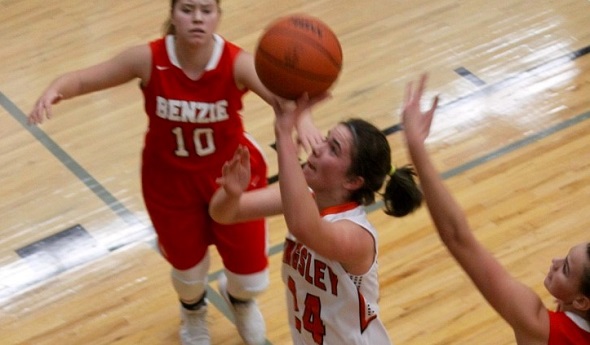
'Me to We' Kingsley Could Make History
February 1, 2018
By Dennis Chase
Special for Second Half
KINGSLEY – It might have been the most thrilling shot of the season for the Kingsley girls basketball team.
 It was certainly the most telling.
It was certainly the most telling.
The memorable moment happened a couple weeks ago when junior guard Jacie King hit a buzzer-beating, half-court shot to give Kingsley an 11-10 lead over Maple City Glen Lake after the first quarter.
Kingsley went on to capture the battle of unbeatens, 61-45.
“They didn’t beat us one quarter (because of that shot),” King said.
Well, nobody has beaten 14-0 Kingsley in a quarter this season. Heading into Thursday’s contest with Onekama, that was 56 quarters and counting.
Not surprisingly, Kingsley, ranked No. 2 in this week’s Associated Press Class B poll, had won 13 of its first 14 games by 34 points or more.
“We’ve been pretty dominant,” said Matt Schelich, now in his 20th season as head coach.
With three weeks to go, Kingsley is within reach of what would be the program’s first 20-0 regular season.
The schedule ahead includes a rematch with once-beaten and reigning Northwest Conference champion Glen Lake, this time on the road Feb. 20.
But the Stags are more concerned about the present than the future.
“We’re taking a one day at a time approach,” Schelich said. “I tell the kids try to win every day, whether it’s in the classroom, at practice, whatever. Keep focused and win every day.”
That’s what his players are doing.
Schelich, who led Kingsley to the Class C Semifinals in 2008, returned the nucleus of last season’s 18-4 squad. It was a season that ended in the District Finals with a loss to Kalkaska, a team the Stags had beaten during the regular season.
“Last year ended in disappointment,” Schelich said. “We felt we had a legitimate shot to win the league and the District. In the long run, it might have been the best thing that happened. It was eye-opening. We didn’t have a focus on what was right in front of us.”
Schelich went to work in the offseason to change the team mindset from “me to we.” His intent was to get his players on the same page and help them “learn to play together,” senior guard Kelsie Bies said.
“If we use all our resources, all our talent, we can be that much better,” Bies said. “I love that about this team. We’ve learned how to trust each other.”
“Nothing we do is for ourselves,” junior forward Marie Pierson added. “It’s about team and how much better we can get (working together). Our motto is “All Heart.” We have to love each other, trust each other because we’re all in it together. We’re working really well together.”
It helps that there’s a strong chemistry between the players.
“What makes this team so special, so awesome, is that we all get along,” King said. “There’s hardly any arguments.”
Schelich rotates as many as eight players – Jalynn Brumfield, Lindsey Boyajian, Brittany Bowman, Bekah Crosby, Maddie Bies, Kelsie Bies, Jacie King and Marie Pierson. Brumfield has signed with Ferris State University, Boyajian with Lakeland University in Wisconsin.
“A majority of these kids could be averaging 20 a game, here or anywhere else,” Schelich said. “Basically, what we have, are eight kids averaging 8 to 12 a game.
“Balance is hard to beat. Balance with depth is really hard to beat. The kids have bought into the we. They don’t worry about who is getting credit.”
Schelich admits it’s a “competitive” group, and often practices are tougher than the games, especially when he can also draw from a 13-1 JV team.
 “We divide our kids so we have two good varsity teams going at it in practice,” he said. “How many coaches can divide their team up, have it be competitive and have their players get better? Not many. Most teams, boys and girls, have two or three kids that have to get it done for the team to have a chance.”
“We divide our kids so we have two good varsity teams going at it in practice,” he said. “How many coaches can divide their team up, have it be competitive and have their players get better? Not many. Most teams, boys and girls, have two or three kids that have to get it done for the team to have a chance.”
The players like the competitive challenge at practice.
“We don’t go easy on each other,” Bies said. “We push each other. Most of the time, our games are not as intense as our practices.”
For Kingsley, it all starts with pressure defense.
“We create a lot of offense with our defense,” Schelich said. “As a group, we are very athletic. I talk about playing defense in waves. That first wave, well, it’s a pain to play against our guards. They are quick and relentless. If you think you’ve got one beat, here comes another one.”
Kelsie Bies is the catalyst on the press.
“She can really move her feet and make people uncomfortable,” Schelich said. “She can go baseline to baseline to make plays. It’s like a beagle on a bunny. It’s her defensive energy, tenacity, that gets us going.”
Bies has stepped up her offensive game as well. Through the first 10 games, she was hitting 49 percent of her 3-pointers.
Kingsley is currently without Boyajian, who has been battling knee injuries.
“She’s had both knees repaired, and one is acting up right now,” Schelich said. “She just had an MRI. We hope to have her back soon.”
But that’s where the depth pays off.
“It’s been a luxury,” Schelich admitted.
Much to the chagrin of opposing coaches.
Frankfort coach Tim Reznich, who has led the Panthers to two Class D titles, is a believer.
“They’re good,” he said. “They have a legitimate shot at being a Final Four team. They have great depth. I think (Schelich) has 9 or 10 kids that could start on any given night. When he’s making substitutions, it’s nothing to look forward to as an opposing coach. They keep the pressure on and, in some cases, turn it up more.
“They have all the tools. They have good perimeter play, solid posts, and they’re good in transition. If you slow them down, they have girls who score in the halfcourt set. It’s a complete team.
“I told Matt (earlier in the season) that he has a special group and to enjoy them while he can. They’re making the best of it. They’re all in rhythm on the court. It’s a fun team to watch.”
And it’s also a team that is starting to get more recognition in the polls.
“It’s definitely exciting to be ranked that high because most people don’t even know where Kingsley is,” Bies said. “But we don’t talk about it. We don’t focus on it.”
Instead, the focus is on improving every day.
“It’s February – we have to get better (for the MHSAA tournament),” Schelich said. “We can’t be content.”
That’s not good news for opponents in the north, especially since this run could last awhile.
“Our 10th, 11th and 12th grades are loaded,” Schelich said. “Three groups in a row, it’s awesome.”
Schelich has two sophomores on varsity in Bowman and Maddie Bies. Plus, more are on the way.
That’s not what opposing coaches want to hear.
“There will be a learning curve for some of the young players when they get there (to varsity),” Reznich said. “But, no question, they’re just reloading the next couple years.”
 Dennis Chase worked 32 years as a sportswriter at the Traverse City Record-Eagle, including as sports editor from 2000-14. He can be reached at [email protected] with story ideas for Manistee, Wexford, Missaukee, Roscommon, Ogemaw, Iosco, Alcona, Oscoda, Crawford, Kalkaska, Grand Traverse, Benzie, Leelanau, Antrim, Otsego, Montmorency, Alpena, Presque Isle, Cheboygan, Charlevoix and Emmet counties.
Dennis Chase worked 32 years as a sportswriter at the Traverse City Record-Eagle, including as sports editor from 2000-14. He can be reached at [email protected] with story ideas for Manistee, Wexford, Missaukee, Roscommon, Ogemaw, Iosco, Alcona, Oscoda, Crawford, Kalkaska, Grand Traverse, Benzie, Leelanau, Antrim, Otsego, Montmorency, Alpena, Presque Isle, Cheboygan, Charlevoix and Emmet counties.
PHOTOS: (Top) Kingsley’s Marie Pierson drives to the basket against Benzie Central last month. (Middle) Jalynn Brumfield cuts through defenders in the Stags’ 67-30 win over the Huskies, who are 12-2. (Photos by Ron Stremlow.)
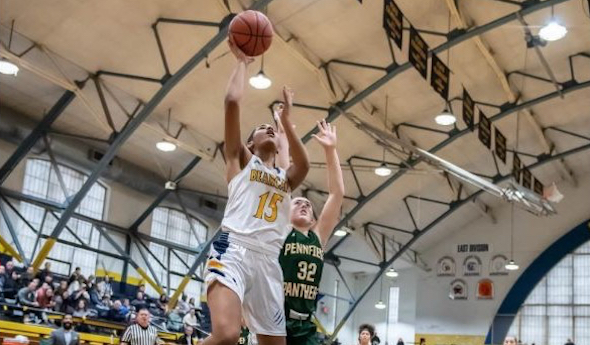
Hoops Finds Annual Home During Holidays
December 27, 2019
By Ron Pesch
Special for Second Half
Nothing says the Holidays like a high school basketball tournament.
It started, like many things do, with a drip. Well, make that a dribble.
The Michigan High School Athletic Association has allowed Holiday basketball tournaments for years. When was the first? That’s hard to establish. No one really kept track of such. A 1934 Wakefield News article indicates that a “Christmas Tournament will be held for the (Gogebic) Range teams at Wakefield December 27 and at Ironwood December 28.” Hurley, Bessemer, Ironwood and Wakefield were entered in the “blind” tournament, with opponents drawn just before game time. It was a new idea, at least in the Upper Peninsula.
“Nothing of its kind has ever been attempted in the Peninsula before,” stated the Ironwood Daily Globe. The tournament, won by Hurley, was a financial success. After expenditures, including the purchase of trophies, profit equaled enough that $22.42 was distributed to each school competing in the tournament. Plans were announced to bring back the tournament in a larger format the following year. It did return the following December, with the same teams in the same format but with all games played in Wakefield. This time out, Ironwood topped Hurley 22-21 for the tournament title.
In the Lower Peninsula in 1935, an All-Berrien County Holiday tournament was held Dec. 26, 27 and 28, with Three Oaks winning the Class B-C division title, 15-13 in the final over Berrien Springs. St. Joseph Catholic emerged as the Class D victor with a surprising 27-26 win over the reigning MHSAA state champ from Stevensville. The 14-team competition was played at Niles High School. Attendance was “slim, very slim” for the opening day of the tourney. The event did not return in 1936.
A similar, but much smaller, event was staged in Berrien County in 1941 with the Bridgman Class C Invitational. The tournament featured seven teams with contests spread over three nights. It was a success.
“Some 450 paid admissions were checked in Wednesday night for the championship finals, which Bridgman won from Berrien Springs. … The total paid admission for the three night event was 1,420 fans with a gross gate of approximately $400.”
By the mid-1940s, the idea of playing prep basketball during the Christmas lull had begun to take off across the state.
In December 1946, before a crowd of 1,500 at the Flint IMA Auditorium, Holland, the reigning Class A champion, downed Flint Northern 51-48 behind a pair of late field goals by Ken ‘Fuzz’ Bauman in the first annual Motor City Invitational. In Jackson, Detroit Catholic Central won the Michigan Catholic Invitational, beating Kalamazoo St. Augustine, 42-40. Bridgman again snagged the title at the Sixth Annual Berrien Class C Christmas Holiday Tournament. It was the Bees’ third Christmas championship in four years. The Little Eight Conference Holiday Tournament was played across four school gymnasiums as the calendar transitioned from 1946 to 1947. Bangor downed Covert, 34-29, in the championship contest hosted at Watervliet High School on Saturday, Jan. 4.
“Holiday tournament basketball has really caught on in Michigan,” said Hal Schram in the Detroit Free Press in 1947. “There will be no Christmas-New Year’s rest for at least 60 Michigan high school squads which have jumped at the chance to sharpen their collective shooting eyes for the long season ahead. … At last count, tournaments will be played between Dec 17 and Jan 3 at Flint, Saginaw, Grand Rapids, Jackson, Lincoln Park, Fremont, Negaunee, Marquette, Benton Harbor and Detroit.”
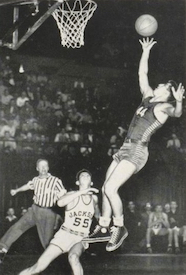 The same eight schools that played at the first Motor City tournament – Jackson, Grand Rapids Central, Holland, Muskegon Heights, Monroe, Midland, Flint Central and Flint Northern – were invited back for the second year. According to Schram, “Not a single participating school of a year ago wanted to be left out.”
The same eight schools that played at the first Motor City tournament – Jackson, Grand Rapids Central, Holland, Muskegon Heights, Monroe, Midland, Flint Central and Flint Northern – were invited back for the second year. According to Schram, “Not a single participating school of a year ago wanted to be left out.”
Jackson downed Flint Northern in the title game, 39-34.
The Saginaw Invitational, hosted at Arthur Hill High School, boasted six Class A schools as well as Alma and Mount Pleasant, both Class B schools. Mount Pleasant surprised the field, winning the tournament with a 40-25 triumph over Dearborn Fordson in the championship game.
A year later in December, Schram wrote, “The Michigan High School Athletic Association wasn’t caught unaware when the tournament bug started to bite every sector of the state.”
“Never did we expect such a wave of tournament play as we will see during the next three weeks,” said Charles Forsythe, state director for the MHSAA, noting 34 Christmas vacation tournaments were scheduled between December 15 and January 8 during the 1948-49 basketball season. “Perhaps we’re lucky at that. The Oklahoma association has had to sanction 123 tournaments.”
Forsythe and Schram explained the reasons for the wave of popularity. Of particular interest was the fact that, at the time, a school sponsoring both football and basketball could play a total of no more than 24 games, combined, in the two sports. However, MHSAA rules allowed a basketball team the chance to play as many as three games during a Holiday tournament and be charged with only one of its allotted combination of 24 contests. (The MHSAA rules changed prior to 1972-73 to allow basketball teams a maximum of 20 games.)
Coaches could keep their squads sharp during the two-week layoff with games rather than just mandatory practices. And, as a bonus to all because tournaments were financed through gate admissions, invitations to larger tournaments meant teams got to “stay and eat at the best hostelries, go on sightseeing tours when not playing and play non-conference opponents from other sections of the state.“
Add in the chance to play before larger-than-normal crowds, and the formula for a successful tournament was cast.
Beginning with the 1950-51 season, the football-basketball rule was altered to count play in mid-season invitational tournaments as two contests. With the change, according to the Detroit Times, “the number of such meets dropped sharply.”
Only nine Holiday tournaments, involving 50-plus teams, were recorded by the MHSAA during the 1951-52 season: the 5th annual Flint Parochial Invitational, the Alpena Catholic Invitational (involving 16 teams), the 5th Annual Greater Lansing Invitational, the Albion College Invitational, the Twin-Five Conference Christmas Tournament (a 10-team replacement for the disbanded Little Eight Conference’s tournament), the Otisville Invitational, the Columbiaville Invitational and the 1st Annual Portland St. Patrick Christmas Invitational.
But by the 1960s, Holiday Tournaments were again regaining popularity, with more now focused on teams from a specific community or section of the state, especially among smaller schools.
The St. Patrick tournament was still going strong in 1966 – its 15th year – with an eight-team, four-day design. Williamston downed a Cinderella squad from Carson City, 64-44, before 1,100 fans at Portland to earn the championship. Other Mid-Michigan holiday tournaments played out in Chelsea and Swartz Creek at the same time.
The Flint Parochial League Tournament was a mainstay of the Holiday season until the breakup of the league in the early 1970s.
“Basketball tournaments have become popular around the state and nation in recent years,” wrote Wendy Foltz, longtime Battle Creek Enquirer sports editor, before the kickoff of the inaugural Battle Creek Central Holiday Cage Tournament in 1968. In a twist that harkened back to earlier days, the eight-team event represented nearly every section of lower Michigan. “Battle Creek never has been a rabid basketball town like some around the state,” added a hesitant Foltz, noting a hope that the event could at least break even.
Hosted at the Cereal City’s historic Fieldhouse, built in 1928, that first tournament was won by host Battle Creek Central, which downed Traverse City 71-53 before a crowd of 2,000. Phil Todd led the Bearcats with 29 points, including 21 in the first half, while 6-foot-8 Tom Kozelko paced TC with 24. Muskegon Heights won the consolation game, holding off a late Ypsilanti Willow Run rally, 78-77. Other schools competing were Battle Creek Lakeview, Grand Blanc, Romulus and recently-opened Jackson Lumen Christi.
Chuck Turner, Central’s head coach, and junior varsity coach Jack Schils had contacted 60 schools during the summer of 1967 to organize the 12-game schedule.
“The response was terrific,” said Schils, who added, “Many schools could not accept because of schedule commitments but want to enter a year hence.”
The Battle Creek tournament was back in 1969, again hosting teams from near and far. Schils noted that cost ran high when teams were brought in from long distances: “However, this type of tournament is highly desirable so we hope fans will support it.”
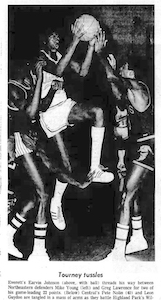
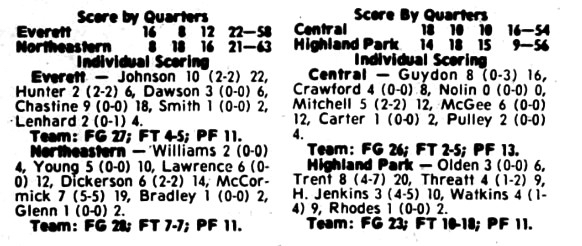 But the event was discontinued following the 1970-71 season when the “eight team format became too unwieldy,” according to the Enquirer “… and both crowd and the quality of play declined.”
But the event was discontinued following the 1970-71 season when the “eight team format became too unwieldy,” according to the Enquirer “… and both crowd and the quality of play declined.”
Pared down to a four-team format, it returned in a big way in December 1975. The tournament saw standing-room-only crowds of more than 3,000 for games between Battle Creek Central, Detroit Northeastern, Class A quarterfinalist Lansing Everett and reigning Class A champion Highland Park.
Detroit Northeastern downed Lansing Everett, 63-58 for the Cereal City championship trophy. Everett junior Earvin Johnson scored 22 points and, with teammate Reggie Chastine, was named to the all-tournament team along with Northwestern’s Wilbert McCormick, the tourney MVP, and his teammate Greg Lawrence. Highland Park’s William Trent and Battle Creek Central’s Leon Guydon also were named to the team.
By the 1980s, it seemed that the Christmas break nearly mimicked March in Michigan.
“I think a Christmas tournament really helps your program,” said Turner in 1980 to the Enquirer. He had taken over the head coaching position at Battle Creek in the fall of 1967 after a successful stint at Willow Run. “I don’t understand basketball teams having a preseason, playing three or four games, then taking two weeks off. When you get back, it’s like starting over.”
Besides Turner’s squad, the 1980 field included Detroit Western, Detroit Murray Wright and eventual winner Kalamazoo Central. The event would ultimately be re-christened the Battle Creek Central Chuck Turner Holiday Classic.
“The late Chuck Turner started bringing big games to the city over the holidays when he first started at the school in the 1960s,” wrote Bill Broderick in the Enquirer in 2018.
“Chuck started this because he wanted to give people the chance to come back home for the holidays and see everyone play. It’s been like a family reunion over the years,” Fred Jones told Broderick. Jones was a longtime assistant to Turner. “That we can keep it going in his name is great and hopefully we can keep if going for another 50 years.”
The girls are now part of the action. All five Battle Creek city schools – Central, Pennfield, Harper Creek, Lakeview, and St. Philip – were part of the event in 2018.
This year the Chuck Turner Central Field House Holiday Classic will again span two days – December 27 and 28 – and will again see all five city schools play on the historic floor.
Other Holiday tournaments scheduled this year include:
Petoskey Invitational – December 13-14
Raider Shootout – December 21
18th Annual Muskegon Area Sports Hall of Fame Classic – December 27
Earl McKee Classic – December 27-28
North Farmington Holiday Extravaganza – December 27
Motor City Roundball Classic – December 27
Cornerstone Invitational – December 27
Washtenaw Hoops Showcase – December 28
 Ron Pesch has taken an active role in researching the history of MHSAA events since 1985 and began writing for MHSAA Finals programs in 1986, adding additional features and "flashbacks" in 1992. He inherited the title of MHSAA historian from the late Dick Kishpaugh following the 1993-94 school year, and resides in Muskegon. Contact him at [email protected] with ideas for historical articles.
Ron Pesch has taken an active role in researching the history of MHSAA events since 1985 and began writing for MHSAA Finals programs in 1986, adding additional features and "flashbacks" in 1992. He inherited the title of MHSAA historian from the late Dick Kishpaugh following the 1993-94 school year, and resides in Muskegon. Contact him at [email protected] with ideas for historical articles.
PHOTOS: (Top) The Battle Creek Central and Pennfield girls face off during the 50th Chuck Turner Classic. (Middle) Shaheen Shaheen scores two points for Flint Northern, which fell to Jackson 39-34 during the 1947 Motor City championship game. (Below left) Lansing Everett’s Earvin Johnson makes a move toward the basket against Detroit Northeastern during the 1975 Battle Creek event. (Below right) Box scores from the 1975 tournament include Johnson’s 22 points in the 63-58 loss. Photos courtesy of the Battle Creek Enquirer, Lansing State Journal and Ron Pesch archives.)

